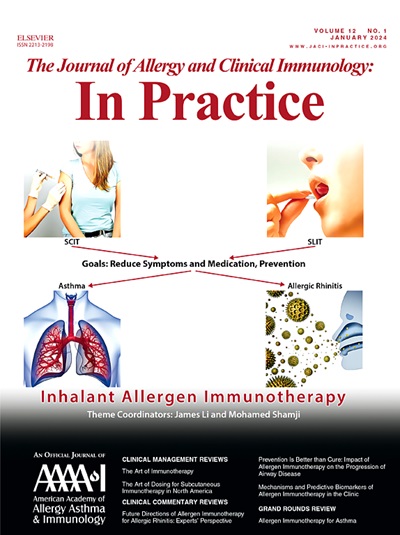与MEFV变体或pyrinopathy相关的新疾病。
IF 8.2
1区 医学
Q1 ALLERGY
Journal of Allergy and Clinical Immunology-In Practice
Pub Date : 2025-03-01
DOI:10.1016/j.jaip.2024.12.022
引用次数: 0
摘要
自身炎症性疾病(AIDs)的特点是先天免疫失调,导致全身炎症。家族性地中海热(FMF)是最常见的艾滋病,与MEFV外显子10的变异有关。该基因编码pyrin, pyrin是炎症小体中的一种关键蛋白质,与先天免疫反应有关。自FMF被发现以来,MEFV的许多其他致病变异已被鉴定出来。除外显子10外,这些变异负责多种自身炎症性疾病,称为pyrin相关自身炎症性疾病(PAAD)或pyrinopathies。外显子10、8、5和3的变异与FMF的显性形式有关。其他与典型FMF不同的炎症临床表现也有可能:PAAND (pyrin相关性自身炎症伴中性粒细胞性皮肤病)的特征是发热发作和与外显子2变异相关的严重中性粒细胞性皮肤病,PAAHe (pyrin相关性自身炎症伴嗜酸性粒细胞增多)在与PAAND不同的外显子2中表现出严重炎症和嗜酸性粒细胞增多相关变异的患者中被描述;PAANi (pyrin相关的与神经炎症相关的自身炎症)表现为全身性炎症、浆膜炎和与外显子9变异相关的神经炎症。FMF的躯体形式也被描述过。我们在此回顾了与MEFV致病性变异相关的各种自身炎症疾病的文献,并提出了一种实用的MEFV相关艾滋病的遗传诊断方法。本文章由计算机程序翻译,如有差异,请以英文原文为准。
New Diseases Linked to MEFV Variants or Pyrinopathies
Autoinflammatory diseases (AIDs) are characterized by dysregulation of innate immunity, leading to systemic inflammation. Familial Mediterranean fever (FMF) is the most common AID, associated with variants in exon 10 of MEFV. This gene codes for pyrin, a key protein in the inflammasome of the same name, involved in the innate immune response. Since the discovery of FMF, many other pathogenic variants of MEFV have been identified. These variants, apart from exon 10, are responsible for a variety of AIDs known as pyrin-associated AIDs or pyrinopathies. Variants in exon 10, 8, 5, and 3 are associated with dominant forms of FMF. Other inflammatory clinical pictures not resembling typical FMF are possible: pyrin-associated autoinflammation with neutrophilic dermatosis is characterized by febrile attacks and severe neutrophilic dermatosis associated with variants in exon 2; pyrin-associated autoinflammation with hypereosinophilia was described among patients displaying severe inflammation and hypereosinophilia-associated variants in exon 2, different from pyrin-associated autoinflammation with neutrophilic dermatosis; and pyrin-associated autoinflammation associated with neuroinflammation manifests with systemic inflammation, serositis, and neuroinflammation associated with variants in exon 9. Somatic forms of FMF have also been described. We present here a review of the literature on the various AIDs associated with pathogenic MEFV variants and propose a practical approach to the genetic diagnosis of MEFV-associated AIDs.
求助全文
通过发布文献求助,成功后即可免费获取论文全文。
去求助
来源期刊

Journal of Allergy and Clinical Immunology-In Practice
ALLERGYIMMUNOLOGY-IMMUNOLOGY
CiteScore
11.10
自引率
9.60%
发文量
683
审稿时长
50 days
期刊介绍:
JACI: In Practice is an official publication of the American Academy of Allergy, Asthma & Immunology (AAAAI). It is a companion title to The Journal of Allergy and Clinical Immunology, and it aims to provide timely clinical papers, case reports, and management recommendations to clinical allergists and other physicians dealing with allergic and immunologic diseases in their practice. The mission of JACI: In Practice is to offer valid and impactful information that supports evidence-based clinical decisions in the diagnosis and management of asthma, allergies, immunologic conditions, and related diseases.
This journal publishes articles on various conditions treated by allergist-immunologists, including food allergy, respiratory disorders (such as asthma, rhinitis, nasal polyps, sinusitis, cough, ABPA, and hypersensitivity pneumonitis), drug allergy, insect sting allergy, anaphylaxis, dermatologic disorders (such as atopic dermatitis, contact dermatitis, urticaria, angioedema, and HAE), immunodeficiency, autoinflammatory syndromes, eosinophilic disorders, and mast cell disorders.
The focus of the journal is on providing cutting-edge clinical information that practitioners can use in their everyday practice or to acquire new knowledge and skills for the benefit of their patients. However, mechanistic or translational studies without immediate or near future clinical relevance, as well as animal studies, are not within the scope of the journal.
 求助内容:
求助内容: 应助结果提醒方式:
应助结果提醒方式:


